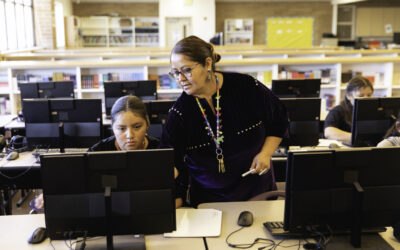As students engage more with online platforms for learning, socializing and entertainment, the importance of managing their digital footprint is important in the present and future skills of digital citizens. Educators play a crucial role in guiding students to comprehend the implications of their digital actions and to cultivate responsible online behavior. By exploring the concept of a digital footprint and integrating practical activities into the K-12 curriculum, students can be empowered to protect their personal information, build a positive online reputation and navigate the digital world with confidence and awareness.
What is a Digital Footprint?
A digital footprint refers to the trail of data that individuals leave behind when they use the internet. This footprint includes everything from social media posts, online purchases, search history and even the metadata attached to photos and emails. It is the collection of information that is shared or collected by online platforms about an individual, either voluntarily or involuntarily.
There are two primary types of digital footprints: active and passive.
Active Digital Footprint: This is the data you intentionally leave online. For instance, when you post a photo on Instagram, comment on a blog or send an email, you are actively contributing to your digital footprint. These are actions you knowingly perform, which result in data being created and stored.
Passive Digital Footprint: This is the data collected about you without your explicit consent or awareness. For example, websites may track your browsing habits using cookies, your location may be logged by apps or your activity might be monitored through various analytics tools. Passive footprints are often invisible to the user but contribute significantly to the overall profile that can be constructed about you online.
Understanding the concept of a digital footprint is crucial in today’s digital age, particularly for students who are increasingly engaging with technology at younger ages. Teaching students about their digital footprint empowers them to make informed decisions about their online activities and helps them understand the long-term implications of their digital actions.
The Importance of Managing Digital Footprints
Managing digital footprints is crucial because it directly impacts one’s privacy, reputation and security in the digital world. Every action taken online—whether posting on social media, making a purchase or even browsing—contributes to a permanent record that can be accessed by others, including potential employers, colleges and cybercriminals.
A well-managed digital footprint helps protect personal information from being exploited, ensures your online presence reflects positively on oneself and reduces the risk of falling victim to cyber threats. By being mindful of what you share and how you interact online, students can maintain control over their digital identity and safeguard future opportunities. Below are examples of why managing digital footprints is important:
- Privacy: An unmanaged digital footprint can lead to a loss of privacy. Information about where one lives, interests, daily routines, and even financial details can be inferred from a digital footprint. Teaching students to manage their digital footprint helps protect their personal information from being misused.
- Reputation: What is posted online can affect how others perceive you. A careless comment or an inappropriate photo can tarnish one’s reputation, which could have long-term consequences, especially as students move into higher education or the workforce. Understanding how digital footprints impact reputation is essential for students.
- Security: A large digital footprint can make an individual more susceptible to cyber threats like identity theft or phishing attacks. Educating students on how to minimize their digital footprint can help protect them from such threats.
- Permanent Record: Unlike a footprint in the sand, a digital footprint can be almost impossible to erase. Once information is online, it can be archived, copied or shared by others, making it challenging to completely remove. Teaching students about the permanence of their digital actions can help illustrate the importance of thoughtful online behavior.
K-12 Activities for Exploring and Managing Digital Footprints
To help students understand and manage their digital footprint, educators can integrate the following activities into the K-12 curriculum:
Elementary School Digital Footprint Activities (Grades K-5)
1. Digital Footprint Mapping:
- Objective: Introduce students to the concept of a digital footprint.
- Activity: Have students create a visual map of their digital footprint using paper and markers. This could include things like games they play online, websites they visit or any other digital interactions. The teacher can guide a discussion on how this map represents their online presence and what kind of information they are sharing.
2. Safe Sharing Scenarios:
- Objective: Teach students what is safe to share online.
- Activity: Present students with different scenarios where they decide whether it’s safe to share certain information online. For instance, should they share their home address with an online friend? After each scenario, discuss the possible consequences of sharing too much information.
3. Footprint Detectives:
- Objective: Help students recognize that their actions leave behind digital traces.
- Activity: Organize a classroom game where students play the role of detectives to discover clues about a fictional character based on their online activities. This can be done through mock social media profiles, search histories and emails. Students will then discuss what they learned about the character and how those details could be used in real life.
Middle School Digital Footprint Activities (Grades 6-8)
1. Digital Footprint Audit:
- Objective: Encourage students to evaluate their existing digital footprint.
- Activity: Have students perform a self-audit by searching for their name and their parents’ names online and noting what information comes up. This exercise helps students see what others can learn about them through a simple search. Follow up with a discussion on how they can control what appears in their digital footprint and the importance of privacy settings.
2. The Consequences of Oversharing:
- Objective: Teach the potential dangers of sharing too much online.
- Activity: Show students real-life examples of how oversharing online has led to negative consequences. These examples can be anonymized case studies or news articles. Afterward, have students create a list of guidelines for themselves on what they will and won’t share online to protect their privacy and reputation.
3. Create a Positive Footprint:
- Objective: Help students understand how to build a positive digital presence.
- Activity: Ask students to brainstorm ways they can create a positive digital footprint, such as participating in online communities, sharing educational content or helping others with their online queries. Students can then work on a project to actively improve their digital footprint, like creating a blog on a topic they are passionate about.
High School Digital Footprint Activities (Grades 9-12)
1. Digital Footprint Case Study Analysis:
- Objective: Analyze the long-term effects of a digital footprint.
- Activity: Present students with a case study of an individual whose digital footprint has impacted their career or personal life. This could include public figures or fictional characters based on real-life situations. Students will analyze the case, discuss what the individual could have done differently and reflect on their digital footprint’s potential long-term impact.
2. Building a Professional Online Presence:
- Objective: Teach students how to manage their digital footprint to benefit their future careers.
- Activity: Guide students through creating a LinkedIn profile or another professional online presence. Discuss the importance of curating a positive digital footprint that reflects their goals and aspirations. Students can then develop a plan to regularly update and manage their professional digital presence.
3. Digital Footprint and College Admissions:
- Objective: Understand how digital footprints are used in college admissions.
- Activity: Invite a college admissions officer to discuss how they use applicants’ digital footprints in the admissions process. Students will then work on a project to clean up and optimize their digital footprint before applying to colleges. This could include reviewing social media profiles, updating privacy settings and removing any questionable content.
Final Thoughts
A digital footprint is an integral and inescapable part of our online lives, encompassing all the data we leave behind, both intentionally and unintentionally. For students, understanding and managing their digital footprint is crucial to ensuring their privacy, security and future opportunities are not compromised. By integrating activities that explore and emphasize the importance of a safe and positive digital footprint, educators can equip students with the tools they need to navigate the digital world responsibly.
Learn more about EasyTech, Learning.com’s premier digital literacy program, by clicking the button below.

Learning.com Team
Staff Writers
Founded in 1999, Learning.com provides educators with solutions to prepare their students with critical digital skills. Our web-based curriculum for grades K-12 engages students as they learn keyboarding, online safety, applied productivity tools, computational thinking, coding and more.
Further Reading
How Were the TEKS Created & What is Its Significance?
The Texas Essential Knowledge and Skills (TEKS) framework details the educational standards in the state of Texas, providing a comprehensive outline...
CIPA Compliance Made Easy with Learning.com
The Children’s Internet Protection Act (CIPA), enacted by Congress in 2000, addresses concerns about children’s access to harmful online content. It...
Students as Logical Thinkers: How Computer Science Teaches Real-World Skills
There is little debate that computer science education has become an imperative curriculum for future-ready students. From modern professions and...




